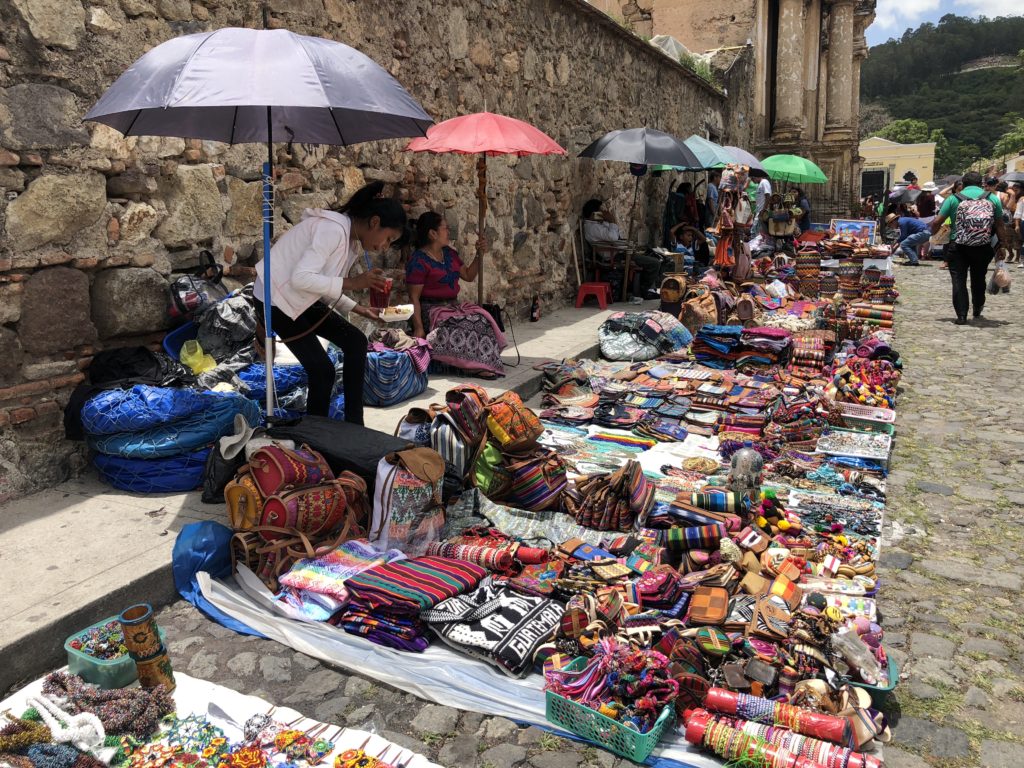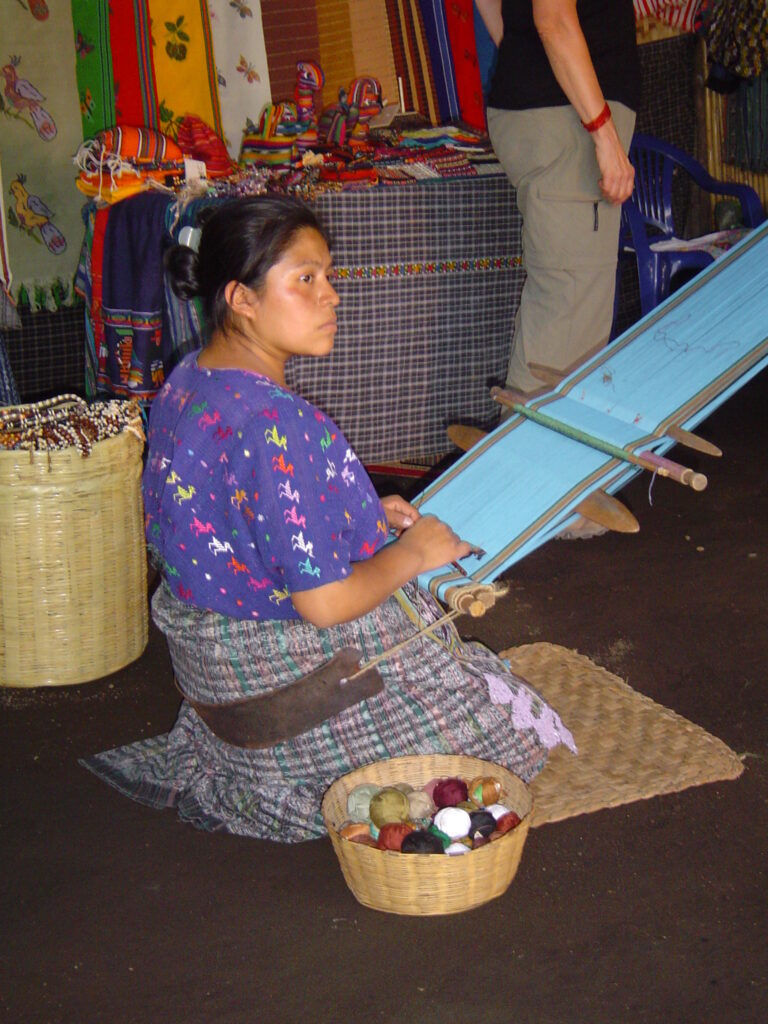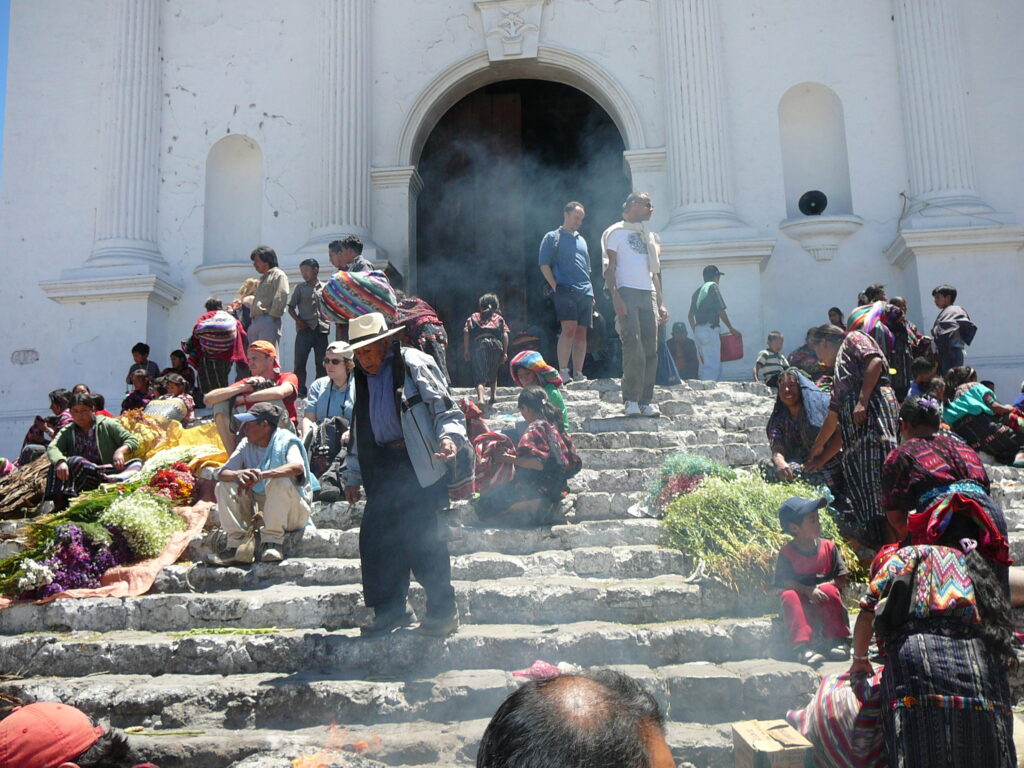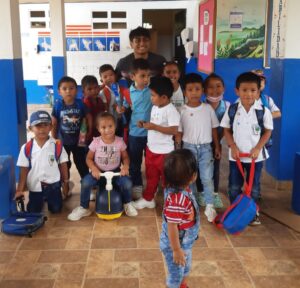About Guatemala
Land and Climate
Nestled between Mexico, Belize, Honduras, and El Salvador, Guatemala is the northernmost country of Central America and one of the most multifaceted in the region. Roughly the size of Tennessee, with a landmass of 41,865 square miles, it encompasses 3 main regions: the cool Western Highlands, Tropical Coastline (along both the Pacific and the Caribbean coasts), and Tropical Jungle in the northern lowlands, known as the Petén. Due to the rich geographical diversity, Guatemala is home to over 8,000 different species of plants in 19 eco-systems. However, because of many developing trends such as migration, peasant farming, illegal logging, and slash and burn agriculture practices, much of Guatemala’s lush landscape has been subject to rapid deforestation. November through April marks the dry season while rain is abundant from May through October.
Population and Language
The Guatemalan population of roughly 15 million can be broadly divided into two categories: Ladino (people with Spanish and Mayan descent who relate more closely with their Spanish heritage) and 28 indigenous groups, or Indígenas, which have descended from the Maya. Many of the indigenous groups live in the western highlands and do not speak Spanish as their first language. Indigenous languages such as Quiche, Cakchiquel, Kekchi, Mam, and Xinca are spoken in the home and in the community. Much of the indigenous female population does not speak Spanish because it is afforded fewer opportunities to attend school. Also, located on the Caribbean coast is a small black population known as the Garífuna. The Garífuna speak Creole, Spanish, and English.
A Brief Overview of Guatemala
Guatemala’s history can be divided into three stages: the Mayan civilization, the arrival of the Spanish during the 16th century, and the modern democratic republic. Guatemala’s historical richness is due primarily to the Mayan civilization, which dates to as early as 2500 B.C.E., reaching its peak between 300 and 900 C.E. Dominating the Mesoamerica region for nearly 2,000 years, the Mayan civilization was based on a series of cultural city centers among which a developed group of artisans, architects, merchants, warriors, priest astronomers, medicine men, mathematicians, and farmers flourished. Although some historians argue that the major Mayan cultural centers lasted until roughly the year 1200 C.E., most agree that the major cities wereabandoned around 900 C.E. The decline of the Mayan civilization was well underway before the Spanish conquistador Pedro de Alvarado conquered Guatemala, in 1523-1524 C.E.
During the Spanish colonial period, Spain introduced a land distribution system in which colonists received large tracts of land, which were worked on by indigenous people, who became indentured serfs. This created a deeply entrenched system of racial hierarchy in which the colonists of European descent were on top, Ladinos (those of mixed blood) in the middle, and the indigenous populations at the bottom. This colonial system existed until the quest for independence started in the early 19th century. Guatemala achieved independence from Spain on September 15, 1821.
The conservative, large landholders and the Church heavily influenced Guatemalan politics through the first half of the 19 th century. However, Guatemala’s 1871 “Liberal Revolution,” led by Justo Rufino Barrios, looked to modernize the country though improved trade, new crops, education, and manufacturing.Beginning in the early20th century, Guatemala passed through a series of dictatorships. During the regime of Manuel Estrada Cabrera (1898-1930), the dictator gave the U.S. owned United Fruit Company (UFC) a controlling percentage of Guatemala’s fertile land as well as control of Guatemala’s only viable port, Puerto Barrios. Combined with the rights to other markets such as transportation, electricity, and communication, the UFC dominated Guatemala’s economy. The trend of ceding national property rights to foreign interests continued under General Jorge Ubico’s (1930-1944) regime. Disillusioned with its government, the “October Revolutionaries,” a group of students and liberal professionals, overthrew Ubico in 1944 and elected Juan José Arevalo as Guatemala’s first democratically elected president.
Known as the “Ten Years of Spring,” this era was a period of reform and progress for Guatemala. However, the “Ten Years of Spring” was overshadowed by the 36-year civil war that erupted in the early 1960s as a reaction to democratically elected Colonel Jacobo Arbenz Guzmán’s Agrarian Land Reform, which looked to redistribute land ownership in Guatemala. The civil war officially ended in 1996 with the signing of the Peace Accords that sought to bring about reconciliation between the warring groups and hold true to the principles of democracy, human rights, and an end to poverty.

Where We Serve in Guatemala
Guatemala is a blessed land with so many different climates and landscapes, going from mountain range, rain forest, jungle, desertic areas and plains. Being the central region with the most stable weather conditions, the most populated and it is estimated that around 5 to 6 million inhabitants live in the central area and the rest live in the other areas. Most of the projects we work on are in the central and central north regions of the country.
Rural
In the central north part of the country, we are going to find a high density of Mayan Indigenous population. This is where most of the rural communities will be, but this is very normal in Guatemala once you leave the central area. We can say with certain that even inside the central areas or big cities you will have a lot of rural areas because of the living conditions.
Semi-Rural
Like many other countries in Central America, Guatemala Semi-Rural areas are right next to big cities, because of its proximity to the Cities, there are more option for the population to work, but at the same time because of a lot of different factors like low income, population still live in rural or semi-rural communities.
The Need in Guatemala
Guatemala’s healthcare system faces challenges typical of developing nations: infrastructure gaps, urban-rural disparities, workforce shortages, and funding constraints. However, these challenges present numerous opportunities for improvement and investment.
One of the many investigations and studies to define Guatemala’s need is shared here. According to OCHA, the main humanitarian concerns in Guatemala include food insecurity, acute malnutrition in children under 5 years of age, and the increased need for protection and basic needs due to the increase in migrant and refugee flows.
Guatemala ranks first in Latin America and sixth worldwide in cases of chronic malnutrition in children under 5 years of age. Nearly half of children (46.5%) suffer from chronic malnutrition. Approximately 5.3 million people need humanitarian assistance, including food, emergency medical services and treatment, access to safe water and sanitation, shelter and protection assistance, including information and referral mechanisms for cases of gender-based violence and other types of violence.
Given its proximity to Mexico and the United States, Guatemala is a country of origin, transit, destination, and return for people on the move, including refugees and asylum seekers.
Our Partnerships
As with any great work, it takes great relationships to get the job done. That’s why ISL Guatemala has partnered with nonprofits, NGOs, and governmental and religious groups and institutions to better serve the people of Guatemala.
Partnerships in Guatemala are selected through long term relationships that make certain that we are working with the right partner. In most cases our partnerships have developed through years of work. They not only demonstrate to be stable, transparent, and meet their goals; more importantly they treat people they serve with dignity and believe they all deserve a better life.
Asociación Bendición de Dios
Xela Aid
Semilla de Esperanza
Hospitalito Santiago Atitlán
What to Expect as a Volunteer
You’ll arrive in Guatemala City via La Aurora International Airport, which is located 30 miles from the downtown La Antigua Guatemala area. After going through Customs and retrieving your luggage, you will be met by an ISL staff member, and transported by taxi, van, or bus (arranged and paid for by ISL) to your hotel or guest house in the province closest to your work site. Airport to hotel travel times vary from 45 minutes to 3 hours. Daily travel time from housing to work site varies from 30 to 45 minutes. On your recreation day, travel may take up to a maximum of 3 hours. Housing locations may change as you move to a new service work site or as you travel to your recreation day location.

Cultural Exploration
With ISL Guatemala, you’ll have many opportunities to explore the culture of those you serve. Here are some of the many possibilities:
Cooking Classes
Learn how to make one of the many famous and delicious Guatemalan dishes and drinks.
Dance Classes
Learn the basics on Salsa, Merengue or Bachata. Or, if you are already advanced, take personal lessons to improve your dance skills.
Tours
Visit numerous archaeological sites, one of many active volcanoes, chocolate making class, coffee plantations, zipline, and if time permits and well organized you can do a day trip to the amazing Mayan ruins from Tikal, where part of the episode IV: A New Hope from Star Wars was filmed.
Local Farmers’ Market in Antigua Guatemala
Although the market is open every day, Mondays, Thursdays and Saturdays are considered the best market days, when the farmers from neighboring communities offer their best deals on their freshest products.
Handicrafts
Taught by members of a local women’s group, you can learn how to make native crafts and have something special to take home when you’re done volunteering.

Recreation
Guatemala has a lot of different recreational activities, from white sand beach on the Atlantic to black sand beach on the Pacific. Jungle, rainforest, active volcanoes, mayan ruins, majestic lakes and many more activities.
Antigua Guatemala Walking Tour
Lake Atitlan Day Trip
Volcan de Pacaya Tour
Chichicastenango Mayan Market (Thursdays and Sundays)
Tikal Day Trip

Lodging
Lodgings for volunteers are unique and carefully chosen based on very important criteria. Accommodations are safe, clean, and within a reasonable driving distance to service sites and recreational opportunities. Volunteers are provided with their own bed, easy access to restrooms and showers, and meeting spaces for training and fellowship. Many ISL accommodations are unique and may include retreat houses, guest houses or home stays – all of which provide a distinctive cultural experience. ISL Country Coordinators provide a description of your lodging in the Final Trip Document posted to your My ISL Portal prior to your departure.
Camelias Inn – https://www.cameliasinnantigua.com/
Hotel Casa Carmina – https://www.hotelcasacarmina.com/
Hotel San Jorge – https://hotelsanjorgeantigua.com/
Hotel Quinta de las Flores – https://www.quintadelasflores.com/
Hotel Mikaso – https://www.hotelmikaso.com/
Hotel Gran Santa Maria – https://www.instagram.com/grandsantamaria/#
Country Coordinator: Jaime de Leon
Where is he from? Where has he lived?
Jaime was born and raised in La Antigua Guatemala, where he has spent most of his life. He lived for some time in California and later moved to Germany with his family in 2011. In 2016, he returned to Guatemala to continue serving his community. He currently lives in La Antigua Guatemala, in the central region of the country.
What does he love most about his country?
He loves Guatemala for its rich cultural heritage, vibrant traditions, and stunning natural beauty. The country is known for its colorful Mayan culture, historic colonial cities, and breathtaking landscapes, including volcanoes, lakes, and lush jungles. Jaime appreciates the warmth and hospitality of the Guatemalan people, perfect climate with mild temperatures all year around and the flavorful traditional cuisine.
What is his family like?
Jaime has three children: Javier (22), Luca (16), and Anna (14). Javier works as a barista in a café in Antigua, while Luca is a junior and Anna a freshman, at an international school there. Jaime’s wife, Silke, is German and has lived in Guatemala for over 15 years; she works as a wedding planner. The whole family shares a love for travel, nature and good food.
Where did he grow up? What was his childhood like?
Jaime was born and raised in La Antigua Guatemala, where he spent most of his childhood. His early years were deeply rooted in the culture and community of La Antigua. Although growing up in Guatemala in the 1990s meant living through a time of significant change, as the country was emerging from a long civil war, which officially ended in 1996, he experienced a relatively carefree childhood with close-knit family life with his two siblings, uncles, aunts and cousins, and strong community ties. Access to technology was limited compared to today, but life was often simpler, with a lot of outdoor play, riding bikes, and slowly evolving technology.
His upbringing in this town played a significant role in shaping his identity and values.
What was the most impactful moment for him during his education?
One impactful moment in his education was when he got to perform an experiment, watching a simple chemical reaction. Through mixing baking soda and vinegar to create an eruption, the invisible forces of science felt real. This experience helped him to shift his view of science from something abstract and difficult to something fun and exciting, and boosted his deeper curiosity for concepts of science.
What has he worked in besides being the Country Coordinator?
Jaime has dedicated the past nine years working as a coordinator and director for Asociacion La Fe en Practica, a non-profit organization that brings surgical teams to Guatemala to provide surgeries for patients who cannot afford them. Through Jaime’s leadership, the organization helps deliver essential medical care to underserved communities, improving the lives of many who otherwise would have limited access to healthcare.
At what point did he realize what his calling was?
Growing up in Guatemala, Jaime was always driven by a deep sense of connection and responsibility to improve the lives of those around them. He had witnessed firsthand the challenges his community faces, such as poverty, limited access to healthcare, or lack of education, and felt motivated to make a positive difference. His strong desire to support the community comes from a commitment to creating better opportunities and building a stronger and healthier future for generations to come.
What was his path to becoming the ISL Country Coordinator?
In 2025, during a conversation with Dr. Patrick Hickey, who was looking for a country coordinator in Guatemala, they both exchanged experiences and realized they were sharing the desire to help others to improve their lives and were meant to work together. Then shortly after that conversation ISL started working with Jaime and developing together the different programs ISL will offer in Guatemala.
How long has he been working with ISL?
Since May 2025
A brief summary of what he does as the Country Coordinator?
As country coordinator Jaime takes care of all the logistics pertaining to teams. Once he gets confirmation from dates and team, he goes on the database and his task is to ensure that he has secure staff, the area they will work in, what they will do for recreation, and make sure that housing, food, transportation, and other needs are in place. He also prepares the budget for the Guatemala programs and is responsible for inventory. He is responsible for doing training for staff as well; if something is lacking when the reports are handed in, he sets up training sessions that he conducts himself along with occasional outside resources. He is also responsible for
monitoring the running of teams, safety and security. He does spot checks to see how things are going on the ground and sometimes works with them to get a feel for how the team leader is running things. He likes to be where the action is and shares with volunteers.
What inspires him most about what he does?
Jaime is inspired through a combination of personal experiences, empathy, and a desire to make a positive impact in Guatemala. Witnessing or learning about the struggles faced by vulnerable communities has awakened a deep sense of compassion and responsibility. Stories of families and patients of resilience and hope in difficult circumstances fuel his motivation to contribute, knowing that even small actions can improve lives.
Guatemala's Staff
We love our staff and we are positive that you will too! Each staff member is professional, courteous, and has the same passion as you do: to serve others.


